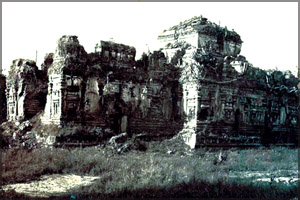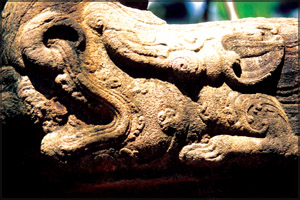|
Heritage splendour
Thivanka Pilimageya:
A fascinating image house
If
you've ever been on a trip to Polonnaruwa, you must have visited the
Thivanka Pilimageya (image house) built by King Parakramabahu
(1153-1186). If you have been to this place, then perhaps, you must be
aware of what I am going to tell you now.
Let me start by telling you how this image house got its name. The
word 'Thivanka' literally means three curves. Since the large image of
the Buddha here is curved in three places, it has been named 'Thivanka'.
|

Thivanka Pilimageya before restoration |
The only Buddha statue in this image house is about eight metres in
height, but today, part of the statue (above the head) has been
destroyed. The building is 133 feet long and 67.6 feet wide. The walls
are 7-12 feet thick, making the internal size of the building much
smaller.
Another fascinating feature of this image house is the corridor
between its internal wall and external wall where visitors can walk. It
should be noted that when you enter the corridor, you must bend your
head to avoid knocking against the wall.
It is also said that you cannot walk along this corridor with your
back to the statue. Both these tactics are believed to have been used to
pay homage to the Buddha.
We can consider the Thivanka Pilimageya as an example of ancient
classical art and a delightful sculpture of the Polonnaruwa era. The
outside walls of the building are beautified with a large amount of
decorative sculpture. Halfway up the wall, a procession of jolly figures
of gana or dwarfs, bursting with total joy of life, are seen.
Famous archaeologist, H.C.P. Bell wrote that so crowded together are
these merry little persons in their pradakshina (paying homage) of a building from left to right that as
many as two hundred and fifty or more once joined the crowd that goes
laughing along the foot of the temple. For it would be hard to find a
more jovial band, male and female, pushing one another with humour with
all the enthusiastic good-natured hospitality, which makes crowds
pleasure-bent.
pradakshina (paying homage) of a building from left to right that as
many as two hundred and fifty or more once joined the crowd that goes
laughing along the foot of the temple. For it would be hard to find a
more jovial band, male and female, pushing one another with humour with
all the enthusiastic good-natured hospitality, which makes crowds
pleasure-bent.
Competing with the dwarfs and vimanas for your attention at the base
of the building is a fresco of spirited lions - lovable, frolicking,
with their well-grown manes and well-trimmed tails.
The Chulavamsa describes this image house as being created out of
brick and wall plaster and a wonderful sight for the eyes. "The Thivanka
image is shimmering with rows of figures of lions, geese and the like,
with many diversely perforated (with holes) balustrades and railings."
However, the best point is the unique murals of the pilimage depicting
stylistic trends of the 12th and 13th centuries.
Some believe that although the Thivanka Pilimage was built by King
Parakramabahu I, King Parakramabahu II, in his attempts at renovations,
painted fresh murals over the existing ones.
This theory is supported by archaeologists who have discovered
evidence of two layers of plaster containing paintings belonging to two
different periods.
It has been recognised that there is a distinct difference in
quality, style and even the subjects of the murals found in the outer
chambers and the inner chambers of the Thivanka image house. However,
the murals at the entrance lack in detail and illustrational quality. In
contrast, the inner paintings show that they are carefully painted.
Again, the paintings in the outer chambers show the Bodhisattva in
his previous births, living in the world of men, while the themes
pictured in the inner chambers in large panels portray the Buddha in a
background of gods.
Art scholars say that elegance, elaboration and magnificence are the
dominant qualities of the murals of the inner chambers. The graceful
expressions on the faces of the gods, the dramatic poses in which their
bodies have been cast and the delicate fingers held in equally dramatic
mudras are a pleasure to behold.
Thivanka Pilimage is the sole surviving example of an ancient
building that retains considerable traces of wall paintings in their
original form. The art of Polonnaruwa is art of the best quality,
classic in its sense and distinguished in its form.
The figures of dwarf sculptures will never fail to catch the eye of
the lover of ancient buildings. Moreover, there is no better place to
enjoy them than at the Thivanka Pilimage in Polonnaruwa.
Compiled by Janani Amarasekara |
